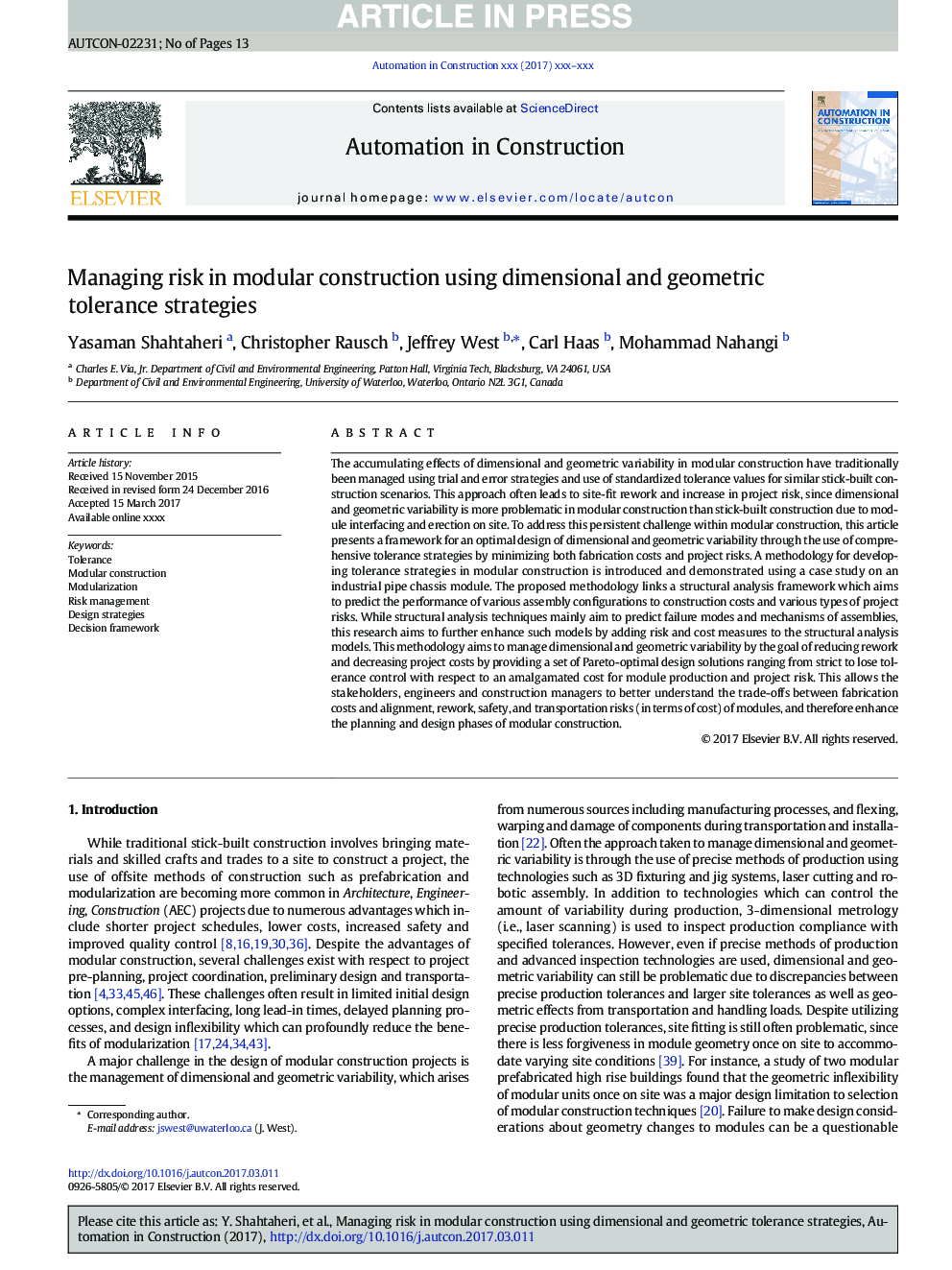| کد مقاله | کد نشریه | سال انتشار | مقاله انگلیسی | نسخه تمام متن |
|---|---|---|---|---|
| 4911234 | 1428280 | 2017 | 13 صفحه PDF | دانلود رایگان |
عنوان انگلیسی مقاله ISI
Managing risk in modular construction using dimensional and geometric tolerance strategies
ترجمه فارسی عنوان
مدیریت ریسک در ساخت و ساز مدولار با استفاده از استراتژی تحمل ابعاد و هندسی
دانلود مقاله + سفارش ترجمه
دانلود مقاله ISI انگلیسی
رایگان برای ایرانیان
کلمات کلیدی
تحمل، ساخت و ساز مدولار، مدولاسیون، مدیریت ریسک، استراتژی های طراحی، چارچوب تصمیم گیری،
ترجمه چکیده
اثرات تجمعی متغیرهای ابعاد و هندسی در ساخت و ساز مدولار به طور سنتی با استفاده از استراتژی های آزمایش و خطا و استفاده از مقادیر تحمل استاندارد شده برای سناریوهای ساخت مشابه ساخته شده است. این رویکرد اغلب منجر به بازپرداخت مناسب سایت و افزایش ریسک پروژه می شود، زیرا متغیرهای ابعاد و هندسی در ساخت و ساز مدولار مشکل تر از ساخت و ساز ساخته شده از چوب به دلیل اتصال به ماژول و نصب بر روی سایت است. برای حل این چالش پایدار در ساخت و ساز مدولار، این مقاله چارچوبی برای طراحی مطلوب متغیرهای ابعاد و هندسی را از طریق استفاده از استراتژی های جامع تحمل با کمینه کردن هزینه های ساخت و خطرات پروژه ارائه می دهد. یک روش برای توسعه استراتژی های تحمل در ساخت و ساز مدولار معرفی شده است و با استفاده از یک مطالعه موردی در یک ماژول شاسی صنعتی صنعتی نشان داده شده است. روش پیشنهادی یک چارچوب تجزیه و تحلیل ساختاری را پیوند می دهد که هدف آن پیش بینی عملکرد پیمان های مختلف مونتاژ برای هزینه های ساخت و ساز و انواع مختلف خطرات پروژه است. در حالی که تکنیک های تجزیه و تحلیل ساختاری عمدتا به منظور پیش بینی حالت های شکست و مکانیزم های سازه ها، هدف این تحقیق این است که این مدل ها را با افزودن ریسک و هزینه ها به مدل های تحلیل ساختاری افزایش دهد. هدف از این روش، مدیریت تغییرات ابعادی و هندسی با هدف کاهش کارایی مجدد و کاهش هزینه های پروژه با ارائه مجموعه ای از راه حل های طراحی مطلوب پارتو می باشد که از کنترل دقیق به کنترل تحمل با توجه به هزینه های آماری برای تولید ماژول و ریسک پروژه می باشد. این به ذینفعان، مهندسین و مدیران ساختمان اجازه می دهد تا بهتر درک مفاد بین هزینه های ساخت و هماهنگی، بازنگری، ایمنی و خطرات حمل و نقل (از لحاظ هزینه) ماژول ها، و در نتیجه فاز های برنامه ریزی و طراحی ساختمان مدولار را افزایش دهند.
موضوعات مرتبط
مهندسی و علوم پایه
سایر رشته های مهندسی
مهندسی عمران و سازه
چکیده انگلیسی
The accumulating effects of dimensional and geometric variability in modular construction have traditionally been managed using trial and error strategies and use of standardized tolerance values for similar stick-built construction scenarios. This approach often leads to site-fit rework and increase in project risk, since dimensional and geometric variability is more problematic in modular construction than stick-built construction due to module interfacing and erection on site. To address this persistent challenge within modular construction, this article presents a framework for an optimal design of dimensional and geometric variability through the use of comprehensive tolerance strategies by minimizing both fabrication costs and project risks. A methodology for developing tolerance strategies in modular construction is introduced and demonstrated using a case study on an industrial pipe chassis module. The proposed methodology links a structural analysis framework which aims to predict the performance of various assembly configurations to construction costs and various types of project risks. While structural analysis techniques mainly aim to predict failure modes and mechanisms of assemblies, this research aims to further enhance such models by adding risk and cost measures to the structural analysis models. This methodology aims to manage dimensional and geometric variability by the goal of reducing rework and decreasing project costs by providing a set of Pareto-optimal design solutions ranging from strict to lose tolerance control with respect to an amalgamated cost for module production and project risk. This allows the stakeholders, engineers and construction managers to better understand the trade-offs between fabrication costs and alignment, rework, safety, and transportation risks (in terms of cost) of modules, and therefore enhance the planning and design phases of modular construction.
ناشر
Database: Elsevier - ScienceDirect (ساینس دایرکت)
Journal: Automation in Construction - Volume 83, November 2017, Pages 303-315
Journal: Automation in Construction - Volume 83, November 2017, Pages 303-315
نویسندگان
Yasaman Shahtaheri, Christopher Rausch, Jeffrey West, Carl Haas, Mohammad Nahangi,
